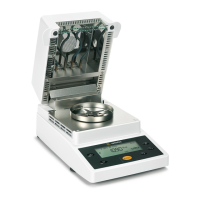18
t Use an appropriate tool for grinding
the sample.
t If the sample is liquid containing solids,
use one of the following tools:
– Glass stirrer
– Spoon
– Magnetic stirrer
Use a disposable sample pan
t Use only Sartorius disposable sample
pans (inner diameter of 90 mm). Reusing
sample pans leads to poor repeatability
of results:
– After cleaning, sample residues can still
remain on the pan.
– Residues from cleaning agents can
evaporate during the next moisture
analysis.
– Scratches and grooves made during
cleaning result in damage that forms
points of attack for hot, rising air
produced during the drying process
(more pronounced buoyancy).
Distribute the sample on the
sample pan
t Distribute the sample on the sample pan
in a thin, even layer (height: 2 to 5 mm,
weight: 5 to 15 g); otherwise:
– A sample applied unevenly will result in a
nonuniform distribution of heat
– The sample will not be dried completely
– The analysis time will be unnecessarily
extended
– The sample will burn or a crust/skin will
form on its surface as a result of a very
thick layer
– The crust makes it difficult or impossible
for moisture to escape from the sample
during the drying process
– An uncertain and unknown quantity of
moisture will remain in the sample
t Apply liquid samples, pasty samples, or
samples that can melt to a glass-fiber
filter (order no. 6906940); this provides
the following benefits:
– Uniform distribution due to the capillary
effect
– Liquids are prevented from beading
together and forming drops
– With larger surfaces, the moisture can
evaporate faster
– Colorless/transparent samples do not
reflect
– Considerably more convenient than the
“sea-sand method”
When drying samples containing sugar,
a crust or skin can form and seal the
surface. A glass-fiber filter is particularly
useful in such cases. The moisture can
evaporate downwards through the
surface of the filter. Crust/skin formation
can be prevented or limited by placing
the glass-fiber filter on top of the
sample.
t Cover solid, heat-sensitive samples with
a glass-fiber filter (order no. 6906940);
this provides the following benefits:
– Gentle heating, because the sample
surface is shielded from excessive heat
– Higher temperature setting can be
selected
– Uniformity of the sample surface
– Fast evaporation of the moisture
– Excellent repeatability for samples
containing fat

